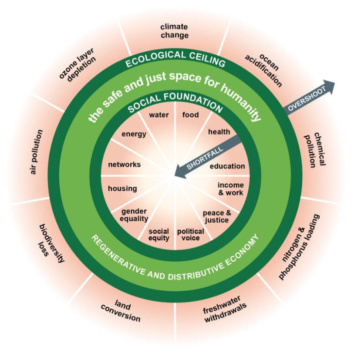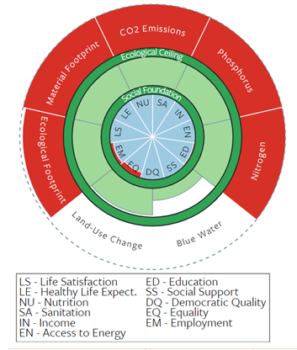If all this phrase has done is conjure up a mouthwatering image of a sugary, doughy, jammy doughnut don’t worry I’m with you! However, if you can manage to draw your mind away from the temptation then this new branch of tasty economics is well worth learning about.
I first came across the phrase Doughnut Economics when I discovered TED talks, the seemingly unlimited fountain of innovative ideas, discussions and knowledge. During the first UK lockdown, listening to the constant news about the collapse of local and global economies, I decided it was time to educate myself about the basic principles of economics. In listening to random talks on YouTube I stumbled across Kate Raworth’s TED talk: Why it’s time for ‘Doughnut Economics’. Naturally drawn to doughnuts over the plethora of other videos I discovered a fascinating topic that I do not believe has received the media attention it deserves…
What is Doughnut Economics?
To understand Doughnut Economics, one must first understand the current general economic model that dictates global, regional and local economies. That model is one of constant growth and that growth is measured by Gross Domestic Product (GDP). We have been conditioned to believe that progress and success should be measured on the metric of money and that the more financial prosperity the greater the success of the systems that hold economies in place.
However, although this target for greater and greater wealth seems desirable it is in fact causing a degenerative economy in the 21st Century. The global economy has become divisive with the vast share of the wealth to a fraction of the globe. Indeed, the gap between the rich and poor in our society is at its greatest for 30 years. We are addicted to growth and consumerism, convincing ourselves that we can transform every time we buy something. However, these addictions are insurmountable.
This desire for an ever-rising line of growth has put strain on our population and environment. So, clearly it’s not working.
This is where the doughnut comes in. First published in 2012 in Kate Raworth’s book: Doughnut Economics: seven ways to think like a 21st century economist, the theory of Doughnut Economics outlines a model that doesn’t focus on continuous GDP growth but shows how humanity can thrive in an equilibrium with the planet’s resources in the ‘Doughnut’. This starts with the acknowledgement that the economy is embedded within, and dependent upon, society and the living world.

The doughnut consists of two rings: a social foundation, ensuring that no one is left wanting on life’s essentials (food, water, medicine etc..), and an ecological ceiling, ensuring that we, humanity, do not overshoot the planetary boundaries that are essential to protecting Earth’s life-supporting systems.
Between these two sets of boundaries lies a doughnut-shaped space that nature and humanity can thrive.
Source: https://doughnuteconomics.org/about-doughnut-economics
Why is it important?
The visual simplicity of the model coupled with the scientific grounding certainly gives hope that there is a reasonable path to a sustainable future. One where environmental health and people’s well-being it treated as an economic driver over money.
Currently, the UK’s doughnut looks something like this:

This is from research done by the University of Leeds who have developed a fantastic resource where you can explore different nations biophysical boundaries transgressed versus social thresholds achieved.
After exploring this it’s clear to see that we have already pushed our planet’s natural limits and many on the planet are not in the space where they are safe and well.
How can the theory be applied?
Alongside core Doughnut, Raworth offers 7 ways to transform our thinking and imagination:
- Change the goal: from GDP growth to the doughnut – ‘endless growth to thriving in balance’
- See the big picture: from self-contained market to embedded economy
- Nurture human nature: from rational economic man to sociable adaptable humans
- Get savvy with systems: from mechanical equilibrium to dynamic complexity
- Design to distribute: from ‘growth will even it up again’ to distributive by design
- Create to regenerate: – today’s economies are degenerative by default- from ‘growth will clean it up again’ to regenerative by design
- Be agnostic about growth: from growth-addicted to growth-agnostic. Nothing in nature grows forever- what we need are economies that make us thrive, whether or not they grow.
If we follow these guidelines then we might be in time to balance the doughnut and bring about the regenerative and distributive dynamics between society and the environment that this century calls for.
Interestingly, the Doughnut Economics Action Lab (DEAL) have scaled down the recommendations from global economies to local economies. This gives cities a plan to incorporate the Doughnut model. Case studies of this can be seen in Amsterdam, Portland and Philadelphia.
Closer to home the DEAL is working with Civic Square in Birmingham to downscale the Doughnut into a tool for transformation at neighborhood scale.
Due to the pandemic our economic systems are in turmoil. Therefore, has there ever been a better time to reassess and bring in new, innovative ideas, such as Doughnut Economics, to ensure that our societies, globally and locally, really do build back better?
I look forward to hearing how this topic gains traction in the future…
If you have found this topic interesting here are some links to follow:
BBC World Service – People Fixing the World, Can doughnuts save the planet?
About Doughnut Economics | DEAL
Amsterdam to embrace ‘doughnut’ model to mend post-coronavirus economy | World news | The Guardian
A healthy economy should be designed to thrive, not grow | Kate Raworth – YouTube
Author: Francesca Johnson, Policy and Insights Analyst at Gemserv.

